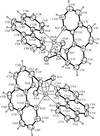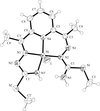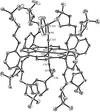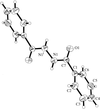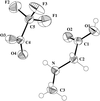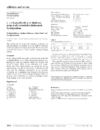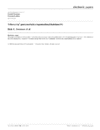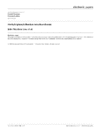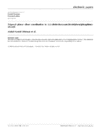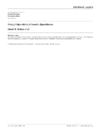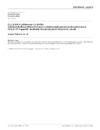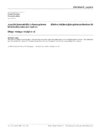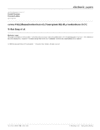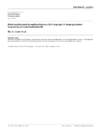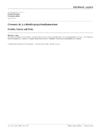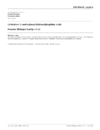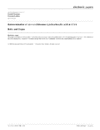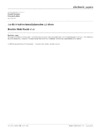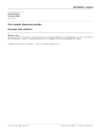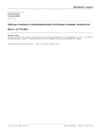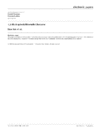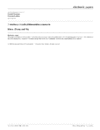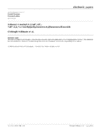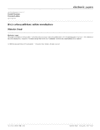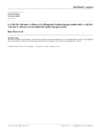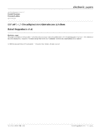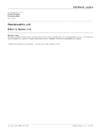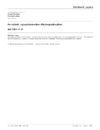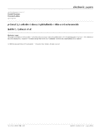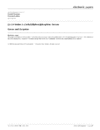issue contents
August 2000 issue

Cover illustration: A mixed-valence iron complex of the antitumour drug 6-mercaptopurine: tris(6-mercaptopurine)iron(II) tetrachloroferrate(III) chloride. Ellipsoids are plotted at the 50% probability level and the tetrachloroferrate(III) anion is not shown. See Schmalle, Gyr & Dubler [Acta Cryst. (2000), C56, 957-959].
inorganic compounds
Download citation


Download citation


The structure of Na2Ce(NO3)5·H2O consists of isolated chains of 12-coordinate Ce atoms. Na atoms and water molecules are located between the chains.
Download citation


Download citation


AgNbO3 is a tilted perovskite which is isostructural with NaNbO3 at room temperature.
metal-organic compounds
Download citation


Download citation


Download citation


Download citation


Download citation


Download citation


Download citation


Download citation


Download citation


Download citation


Download citation


Download citation


Download citation


Download citation


Download citation


Download citation


Download citation


Download citation


Download citation


Download citation


Download citation


Download citation


Download citation


Download citation


Download citation


Download citation


Download citation


Download citation


Download citation


Download citation


Download citation


Download citation


Download citation


Download citation


Download citation


Download citation


Download citation


Download citation


Download citation


Download citation


Download citation


Download citation


organic compounds
Download citation


Download citation


Download citation


Download citation


Download citation


Download citation


Download citation


Download citation


Download citation


Download citation


Download citation


Download citation


Download citation


Download citation


Download citation


Download citation


Download citation


Download citation


Download citation


Download citation


Download citation


Download citation


Download citation


Download citation


Download citation


Download citation


Download citation


Download citation


Download citation


Download citation


Download citation


Download citation


Download citation


Download citation


Download citation


Download citation


Download citation


Download citation


Download citation


Download citation


Download citation


Download citation


Download citation


Download citation


Download citation


Download citation


Download citation


Download citation


Download citation


Download citation


Download citation


Download citation


Download citation


Download citation


Download citation


Download citation


Download citation


Download citation


Download citation


Download citation


Download citation


Download citation


Download citation


Download citation


Download citation


Download citation


Download citation


Download citation


Download citation


Download citation


addenda and errata
Download citation


Download citation


Free 

electronic papers (inorganic compounds)
Download citation


Download citation


The least protonated hexamolybdoplatinate(IV) polyanion, [H2α-PtMo6O24]6−, was isolated by using Nd3+ as a counter-cation. Two O atoms of the central PtO6 octahedron are protonated.
electronic papers (metal-organic compounds)
Download citation


Download citation


The title compound adopts a monomeric three-legged piano-stool structure with one benzyl ligand disordered between two sites related by a ∼30° rotation about an axis defined by the Hf atom and the ipso-C atom of the benzyl ligand. There are no short Hf⋯Cipso contacts (no distances less than 3.1 Å), indicating no significant Hf–Ph interactions.
Download citation


Download citation


The novel title ruthenium(II) complex was synthesized from the reaction of 1,2,4-triazepine, a new class of bidentate ligands, with [Ru(p-cymene)Cl2]2. The 1,2,4-triazepine ligand is coordinated to the metal centre through the N-4 and S atoms, forming a four-membered chelate ring. This is the first structural example of a transition metal complex containing a 1,2,4-triazepine ligand.
Download citation


Download citation


In methyltriphenylstibonium tetrafluoroborate, prepared from triphenylantimony and trimethyloxonium tetrafluoroborate, there are four independent cations and anions in the asymmetric unit. The geometry around the Sb atom is distorted tetrahedral.
Download citation


Download citation


The three-coordinate Ag atom in the title compound, prepared from bis[acetato(triphenylphosphine)silver] hemihydrate and 3,5-nitrobenzoic acid, shows trigonal–planar coordination [P—Ag—P = 147.1 (1)° and ΣAg = 359.0 (3)°]. Adjacent molecules are linked through the O atoms of adjacent nitro groups [Ag⋯O = 3.205 (3) and 3.302 (4) Å] into a zigzag chain running parallel to the c axis of the monoclinic cell.
Download citation


Download citation


The title compound is isomorphous with the ZnII and RuII analogues. A twofold axis passes through the metal atom and the midpoint of the C—C bond joining the two pyridyl rings of one of the bipyridyl ligands. Thus, the asymmetric unit contains one metal on a special position, one perchlorate, and one and a half bipyridyl ligands.
Download citation


Download citation


The complex cation of the title complex crystallizes in two different conformations. Both CuII ions lie on twofold axes and have a planar coordination.
Download citation


Download citation


The Ru atom in the title complex shows an octahedral coordination. The benzonitrile ligands are in the same plane as the o-benzoquinone diimine ligand. Bond distances for the benzoquinone diimine ring establish a quinone arrangement, showing that the highly acidic behaviour of the benzonitrile ligands does not influence the arrangement.
Download citation


Download citation


The title complex has a double carboxylate-bridged infinite-chain structure with one chelating carboxylate group on each Eu ion centre, which also binds to two water molecules to yield an eight-coordinate square-antiprismatic geometry.
Download citation


Download citation


The title complex crystallizes as an ion pair linked through a bridge. There are two independent molecules in the asymmetric unit with essentially identical metric parameters, but appreciably different conformations.
Download citation


Download citation


The title complex has 2:2 stoichiometry with Ci symmetry. Each Ba2+ ion is nine-coordinate, including one N atom and four O atoms of the macrocyclic ligand, two N atoms of the thiocyanate ligands and one O atom from each of the tropone units.
Download citation


Download citation


In the crystal structure of the title compound, the AuI atom has a distorted tetrahedral geometry consisting of one uncoordinated dimethylformamide molecule, one trithiocyanurate ligand and three PPh3 ligands. The Au—S distance is 2.909 (2) Å and the average P—Au distance is 2.403 Å.
Download citation


Download citation


The crystal structure of the title compound consists of layers built up from chromate anions alternating with 2,2-dimethylpropylenediammonium cations. N—H⋯O hydrogen bonds contribute to the cohesion and stability of the structure.
Download citation


Download citation


The title complexes, (I>) and (II>), respectively, show similar square-planar coordination geometries with modest deviations from ideality. In both complexes, the positioning of the oxazine rings results in an unsymmetrical distortion of the I—Pt—N angles, with one expanded by approximately 4° and the other contracted by approximately 2°.
electronic papers (organic compounds)
Download citation


Download citation


Pairs of individual molecules containing tetrahedrally coordinated P atoms are connected across crystallographic inversion centres via complementary O—H⋯O=P hydrogen bonds.
Download citation


Download citation


The structure of the title compound, C8H10O4, originally determined at room temperature, has been redetermined at 173 K. There are no significant differences between these structures.
Download citation


Download citation


In the title compound, C18H18N2O4, the piperidine ring adopts a chair conformation. The 4-hydroxybenzyl groups are in quasi-axial positions. A two-dimensional network is formed through N—H⋯O and O—H⋯O intermolecular hydrogen bonds and C—H⋯O interactions.
Download citation


Download citation


One dideoxynucleoside, (I>), is an analogue of (S,S)-isodideoxyadenosine and is structurally similar but is anti-HIV inactive. Compound (II>) is a novel isomer with the sugar attachment at N3 of the base. The two independent molecules differ in the conformation of the sugar ring.
Download citation


Download citation


The anion in the title compound has a strong intramolecular O—H⋯O hydrogen bond of 2.430 (2) Å. The water molecule lies on a twofold axis and connects the anions into pairs and the centrosymmetric cations into chains through hydrogen bonding.
Download citation


Download citation


In the title potentially tetradentate N,S,S,N-donor ligand, the two S atoms adopt a trans conformation, lying above and below the benzene ring. The two quinoline rings are planar, with one parallel to the benzene ring and the other nearly perpendicular to it.
Download citation


Download citation


Molecules of the title compound, prepared by the condensation of 7-methoxy-3-aminocoumarin with salicylaldehyde in chloroform, are planar and adjacent molecules are linked by electrostatic C—H⋯O interactions into a linear chain.
Download citation


Download citation


The crystal structure of the title compound shows cis annulation of the fused rings of the perhydroindene substructure, as well as a 4R* configuration of the sulfonamido group.
Download citation


Download citation


The title compound exhibits a complex three-dimensional network of hydrogen bonds. Its suitability for possible charge–density study was investigated but the quality of the crystals did not seem sufficient for this purpose.
Download citation


Download citation


The stereochemistries at positions 2 and 3 of the title compounds, (I>) and (II>), have been confirmed by X-ray structural analysis to be R and S, respectively. The halogen atoms adopt an antiperiplanar arrangement in each case.
Download citation


Download citation


The structure analysis of the title dispiro compound establishes a cis configuration of the two five-membered-ring lactones fused to the six-membered carbocycle.
Download citation


Download citation


The crystal structure of the title compound, O=P(OH)(H)(C6H5), shows a continuous hydrogen-bonding network in the x direction, with a P—O⋯O=P distance of 2.513 (3) Å.
Download citation


Download citation


n-Propylammonium dihydrogenphosphate is ferroelastic. Ferroelastic switching is concomitant with the hopping of some H atoms involved in hydrogen bonds from donor to acceptor O atoms.
Download citation


Download citation


The reduction of (1R,8R,11R)-3,3,11-trimethyl-6,6-ethylenedioxybicyclo[6.3.0]undecan-2-one, (I>), by LiAlH4 gave exclusively a (1R,2R,8R,11R)-alcohol, (II>). The conformation around the eight-membered carbocycle in (I>) differs markedly from that in (II>).
Download citation


Download citation


The title compound was synthesized from an azidopregnene derivative. The dihydro-1,3-oxazine ring is connected in the β position to the sterane skeleton at C-17. An R configuration was found at C-20.
Download citation


Download citation


The furanose ring in the title compound adopts an envelope conformation with the ring O atom displaced above the plane (OE). The pseudo-rotational phase angle (P) is 88.6° and the puckering amplitude (τm) is 31.5°. The aglycone lies in the exo-anomeric effect preferred position with a C2—C1—S—C(Ph) torsion angle of −163.2 (2)°.
Download citation


Download citation


The title compound is a phosphine ligand protected by borane adduct formation. The P—B bond length of 1.923 (3) Å is within the expected range. The indene moiety is essentially planar.


 journal menu
journal menu
















